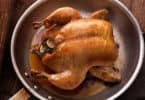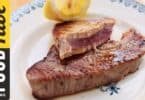Contents
Baked Salmon with Balsamic Vinegar
It is often difficult to figure the exact baking time of Salmon fillets or steaks. There are a few reasons that contribute to this; first, salmon is a very meaty fish, meaning that the flesh is dense. Also Salmon may be purchased in a variety of cuts. Fillets will take less time to cook than a steak, because they are often cut more thin. Steaks are the most difficult to cook correctly because of the bone in the middle. The bone may be removed, but that will cause the steak to dry out during cooking. Salmon must always be cooked at about 400° Farenheit for optimal results. Fish cooks fast and must be baked at a high temperature to kill bacteria and cook the flesh evenly. The lowest possible temperature to cook Salmon is 350°, but this may result in a dried fish, unless it is completely wrapped in foil.
For optimal baking results, each fillet or steak should be coated with olive oil, margarine or butter and then about 1 teaspoon of lemon juice should be drizzled over it. Pepper and salt may be added, but generally it is better to salt the fish after it has completed cooking. When baking fish in the oven, the flesh tends to dry out faster if it is salted. Before baking the Salmon in the oven, be sure to line the pan with aluminum foil. The skin on Salmon often includes scales which will cause erosion to teflon pans; additionally it will stick to glass pans and cause a burnt-on residue that is very difficult to wash off. One important thing to remember about determining when Salmon is done baking is to check it with a fork. When pressing on the flesh, it will not feel soft anymore, it will feel more resistant to pressure. Also the flesh will take on an opposite appearance than that of when it was raw. Raw Salmon is pink with white lines. When Salmon is done it will look white with pink lines. To ease the difficulty in determining various baking times, here is a helpful and detailed reference for various sizes and cuts of Salmon and how long they must remain in the oven:
● Middle Fillet
This fillet is one of the thickest cuts at about a 2″ thickness, coming from the middle section of the fish. The best way to cook the thicker fillets is to use 400° as the set temperature and bake the fish for 18-20 minutes. If a lower heat is desired, season the fillet and wrap it in foil, sealing it tightly and bake at 350° for about 25-30 minutes.
● Thin Fillet
Thin fillets are either closer to the tail or taken from a smaller fish. Usually a fillet of 1″ or less is considered thin. For a fillet that is about 1″ thickness, bake the fish at 400° for about 10-12 minutes. When using a foil wrap, the fillet should be baked at 375° for about 15-20 minutes.
● Tail Fillet
The tail tip is the thinnest fillet and often the most tender. When seeking a cut of Salmon other than a steak, this will often be the best choice. Bake the tail at 415° for optimal results. This cut should be baked for a total of 12-15 minutes. When baking a tail wrapped in foil, use 375° as the heat setting and bake the fish for 20-22 minutes.
● Salmon Steak
Steaks of course are much thicker than a fillet. For each 1″ of thickness, figure on 10 minutes of baking time. Steaks should be baked uncovered at exactly 400°.
<>







